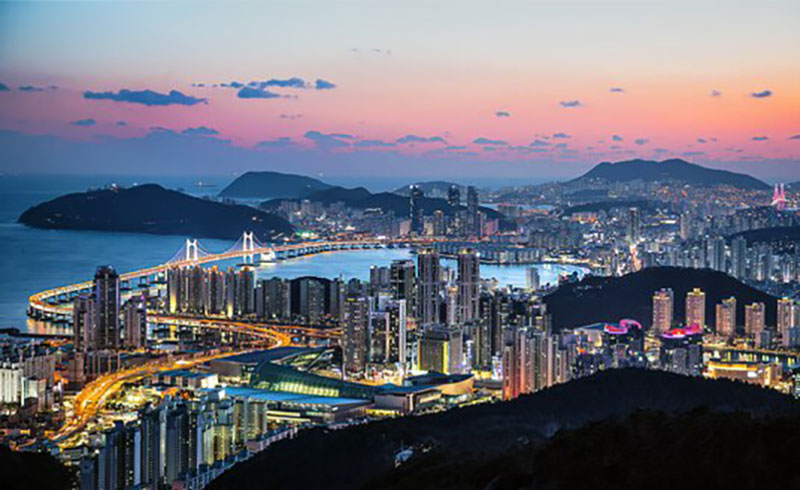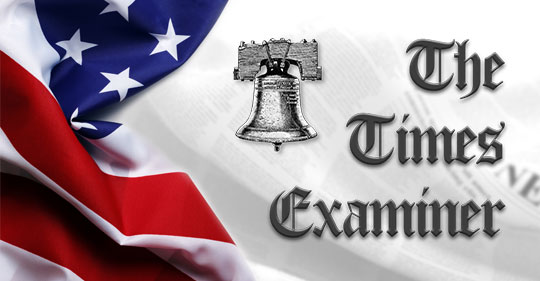Tense but Productive Agreements for 12-Month Probation

Busan (Pusan until 2000) is the second largest city in South Korea. Located in the southeast corner of the Koran Peninsula, it has a metropolitan population of 3.3 million. It is the sixth largest container port in the world. It is famous not only for its port facilities but also its beautiful beaches and surrounding mountainous terrain. It is a popular resort, convention, and recreation area as well as a thriving commercial center.
If you are old enough to remember the Korean War, you may recognize it by its older spelling of Pusan. The Pusan Perimeter was a 140-mile last-ditch perimeter defending the city, port, and critical Allied war supplies in Pusan, following the retreat of South Korean, U.S., and United Nations forces from the North Korean invasion beginning on June 25, 1950. It was the scene of a major defensive battle against North Korean forces from August to September 1950, where U.S. and South Korean forces continued to hold until the North Korean Army was flanked and routed by General Douglas MacArthur’s brilliant execution of Naval bombardments and amphibious Marine landings at Inchon. The Port of Inchon, bordering the Yellow Sea on the western coast of South Korea was only 37 miles from the South Korean capital of Seoul. Inchon is now spelled Incheon and serves as a major airport for Seoul.
The decisive Allied Naval and Marine victory on September 15, 1950, forced North Korean forces to withdraw from Pusan or be cut off and destroyed. U.S. Navy destroyers, cruisers, and aircraft from 5 aircraft carriers under Admirals Arthur Struble and James Doyle began demolishing North Korean port defenses on September13. Three amphibious forces of the First Marine Division landed and captured Inchon on September 15. Operation “Chromite” included 261 U.S. and Allied ships and naval craft, with the British Royal Navy playing a significant role. The Fifth Marine Division recaptured Kimpo (now spelled Gimpo) Airbase at Seoul on September 18, and USAF combat and transport aircraft began supporting the operation. USAF RF-80 reconnaissance aircraft and Air Force photo-intelligence personnel played a critical role in determining the feasibility of and planning the Inchon landing beginning in late August.
Operation Chromite was completed by September 19, and MacArthur signaled that "The Navy and Marines... never shone more brightly" than at Inchon.” Indeed, Inchon has to rank as one of the most impressive victories of American naval and military history. Seoul was liberated on September 29. Allied casualties for Inchon and Seoul included 665 killed and missing. North Korean killed-in-Action (KIA) totaled 14,000, some multiple of that wounded, and another 7,000 captured.
If it had not been for the heroic defense at Pusan and the brilliant victory at Inchon, Busan (still pronounced Pusan, except by U.S. media) would be part of a unified Communist Korea.
So the South Korean military airbase at Busan was of great historical significance for the meeting of U.S. President Donald Trump and Chinese President Xi Jinping on October 30.
According to a China Briefing summary immediately following the surprisingly short one hour and twenty-minute Summit meeting on October 30, the United States and China agreed to cut tariffs, suspend China’s rare earth export restrictions, and pause U.S. port fees for Chinese or Chinese built ships. In addition, Agriculture purchases, fentanyl cooperation, and the TikTok deal were discussed and approved. The meeting largely finalized talks between American and Chinese officials in Kuala Lumpur, Maylasia, earlier in the week. These agreements provided temporary relief for businesses and laid the groundwork for broader negotiations. According to China Briefing, this signaled a shift toward a more stable and institutionalized framework for managing economic relations between the two countries.
Taiwan was wisely not discussed. There needs to be a time for it, but it would have cut the October 30 meeting to about ten minutes. According to Treasury Secretary Scott Bessent, the TikTok turnover was signed by the Chinese two days previously on October 28 in Kuala Lumpur.
Although Trump seemed reasonably upbeat, Xi appeared “icy” in his demeanor and statements. The agreements, while positive, are regarded as probationary for one year contingent on favorable trade and other U.S. and China relations, including political and national security issues.
Trump described the results as a 12 out of 10. In one sense, this is absolutely true. Trump was most eager to restore U.S. imports of rare earth materials from China. China has a 90 percent monopoly on rare earth refining. These rare earth minerals are critical to high technology production and especially U.S. defense technology. The super-high-tech U.S. and NATO F-35 Lightning II multirole fighter jet with its stealth, sensor fusion, and network integration capabilities is dependent on rare earth materials for production and operation. The main strike weapon of the Israeli Air Force is also dependent on the F-35 and rare earth materials. This is just the most obvious example among scores of critical technology and military needs. China has a near-monopoly on refining materials crucial to our national defense and national security. It is not Trump’s fault that we are beggars for rare earth materials, but common sense dictates that we should not unnecessarily provoke economic or military tensions with China. How long will it take the U.S. to become rare-earth-refining independent. Some say only a year or two, and others say as long as ten years.
China announced its suspension of rare earth materials exports to the U.S. on October 9 in response to two U.S. trade war announcements. The most important was the 50 Percent Ownership Rule effective for one year announced by the U.S. on September 29. The 50 Percent Rule held that any business or entity more than 50 percent owned by an entity blacklisted by the U.S. Commerce Department would be subjected to extremely strict import regulations, effectively putting them out of business in the U.S. and perhaps with U.S. allies. This extended the number of Chinese companies severely impacted from 1,300 to over 20,000. This is very complex and manipulatable, but includes very legitimate issues like military end uses of products (MEU). However, China was outraged, and thus suspended rare earth material exports to the U.S. The October 30 meeting agreed to suspend both the 50 Percent Rule and Chinese blocking of rare earth materials exports to the U.S. for a year.
A second issue on U.S. port fees on Chines owned, Chinese operated, or Chinese built ships also outraged the Chinese. On October 3, 2025, the US Customs and Border Protection (CBP) issued detailed guidance on implementing those fees, which took effect on October 14. Under the new rules, Chinese-owned or operated vessels were to be charged $50 per net ton (NT), while Chinese-built vessels faced an [additional] fee of $18 per NT or $120 per container discharged, whichever was higher. Vehicles carrying cargo onto or off ships were also subject to a separate fee. These rates were scheduled to rise annually to a high of $33 per NT or $250 per container for Chinese-built vessels in 2028.
The background on this is that U.S. shipbuilding and shipbuilding capacity has declined dramatically since World War II. The U.S. now produces less than one percent of world production, and its capacity for building ships has similarly declined. There are a combination of reasons for this alarming decline, but none of them reflect enlightened economic and political policies. The Chinese now produce close to 60 percent of all global shipbuilding. This does not paint an optimistic outlook for the U.S. to maintain what is presently far and away the most powerful Navy in the world. China presently has more naval ships than the United States, but they are predominantly smaller coastal defense ships. The Russian Federation is a continental rather than an oceanic power, but the number and quality of its submarines is exceeded only by the United States with 70 submarines verses 63 for Russia. Both in commerce and national security, the U.S. decline in shipbuilding capacity is a substantial problem.
Trump, to his credit, on April 9, issued an executive order purposed to address the problem by revitalizing and rebuilding domestic industries and a workforce to promote national security and economic prosperity. However, the application regarding port fees for China was received as arrogant hostility. Fortunately, this incredibly abrasive and unthinking policy, has been suspended for a year. It has nothing in common with peace through strength and more closely resembles war by misguided arrogance.
Fentanyl Tariffs
On February 1, 2025, Trump signed an executive order imposing an additional 10 percent tariff on all Chinese goods entering the country, ostensibly to hold China accountable to its promises for stopping fentanyl and precursor chemicals from flowing into the US. That additional 10 percent tariff has been suspended contingent on Chinese promises to reduce this flow. The discussion, however, was intense, with Secretary of the Treasury Scott Bessent taking heat from Chinese officials on U.S. representation of China as having principal responsibility for the Fentanyl problem in the U.S.
Soybeans—a huge financial impact important to American farmers.
Secretary Bessent also announced that China had agreed to purchase 12 million metric tons of soybeans this year and 25 million metric tons for the next year, the usual purchase volume over the 7 years preceding the current tariff war. This is good news to American soybean farmers. According to the American Soybean Association, this is 28 percent of the average annual American soybean production. Argentina and Brazil are the major U.S. competitors for Chinese soybean imports.
I will not try to go through the recent ping pong match of retaliatory tariffs here. According to U.S. accounts, the tariffs on China fell from an average of 57 percent to 47 percent as a result of the October 30 Summit. British commentator Alexander Mercouris said on November 1 that some economists have estimated a substantially lower average tariff than 47 percent for China. There is too much contrivance of smoke, mirrors, confusion, and related shell-games and balderdash in my opinion to venture an estimate.
Tariffs have had a controversial and divisive history in the United States. In fact, there is compelling evidence that a 40-year tariff struggle between Northern industrial states and Southern agricultural states, culminating in the Morrill Tariff in 1861, was a major provocation to initial Southern secessions, resulting in the “Civil War.” The mandatory politically correct American narrative on the Civil War is that it was a struggle to end slavery. This sounds virtuous, but the truth is far more complex and tainted with blind greed and a drive to establish unchallenged political and economic power. I published a paper on this in 2012 and updated it in 2021 with new statistical evidence. The paper also details the tragic impact of the1930 Smoot-Hawley Tariff. The Title is: The Morrill Tariff: Northern Provocation to Southern Secession. I will be glad to email it to those interested or provide a printed copy for $7.
Tariffs may temporarily benefit new or critical industry in the short to intermediate time frame, but they are generally harmful on balance. They may benefit specific industries or regions but in the process harm other industries and regions to various degrees, sometimes substantially. They are usually harmful to consumers and most workers, causing higher prices and shortages. They are especially harmful to exporters, most notably agricultural exporters. They also tend to discourage competitive innovation, resulting in industrial drags on taxpayers and the economy.
I will rest my case on the nature and dangers of tariffs with President Ronald Reagan, a fervent but pragmatic supporter of free trade. See the full, 5-minute and 10-second, April 25, 1987, radio address on Free and Fair Trade on YouTube, which you may click below.
https://www.youtube.com/watch?v=Foggkeiwlp0
This short video has been subject to antagonism and attempted denial on the internet, but I hope you can open it or find it.
Truth is reality, but it is often difficult to determine and difficult to receive. Courage is usually necessary for its effectiveness, but it is best held in humility—simple honesty.
“Honesty is the first chapter of the book of wisdom.”—Thomas Jefferson









 Mike Scruggs is the author of two books: The Un-Civil War: Shattering the Historical Myths; and Lessons from the Vietnam War: Truths the Media Never Told You, and over 600 articles on military history, national security, intelligent design, genealogical genetics, immigration, current political affairs, Islam, and the Middle East.
Mike Scruggs is the author of two books: The Un-Civil War: Shattering the Historical Myths; and Lessons from the Vietnam War: Truths the Media Never Told You, and over 600 articles on military history, national security, intelligent design, genealogical genetics, immigration, current political affairs, Islam, and the Middle East. 


